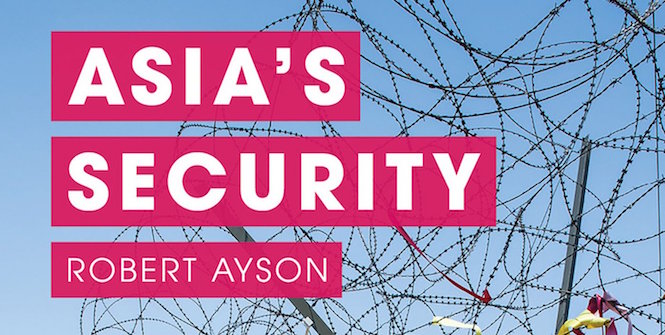Asia’s Security

In this survey of the security challenges facing the region, Robert Ayson, Professor of Strategic Studies at Victoria University, Wellington, tackles a huge, multi-faceted and fast-changing topic with aplomb.
To make his task manageable, Ayson focuses primarily on East Asia and parts of South Asia, treating Australia and New Zealand, the South Pacific, most of Central Asia, Russia and the United States as ‘borderlands’ which are occupied by actors that can and do impinge upon the core area but are less regularly or intimately engaged.
Wisely, Asia’s security is also considered thematically, rather than country-by-country, or in terms of abstract academic categories like ‘traditional’ and ‘non-traditional’ security. In theoretical terms, indeed, this is a self-consciously heterodox book. Security is broadly defined as a ‘condition or quality of the environment in which an actor exists’ – a condition or environment in which there is little or no ‘exposure to threats of harm’ – a definition that permits Ayson to consider the national security of states and the human security of individuals and communities alongside one another.
Ayson begins his thematic chapters with ‘peace.’ He notes that ‘major wars in Asia are now very rare,’ though intrastate conflict remains rife. But he argues that interstate wars have not declined because Asian elites have come to believe they are ‘unthinkable as instruments of policy.’ He also sets aside the argument that the spread of nuclear weapons to major Asian and borderland states is responsible for the infrequency of major war, though he observes that in certain crises they seem to have made leaders more cautious. And he is rightly sceptical about claims that economic growth has diminished interstate conflict, pointing to rises in defence expenditure across the region. Instead, Ayson argues that the stabilising influence of the United States combined with developments internal to key regional states that shifted them from fragile postcolonial entities into more robust polities helped keep the peace from the 1970s well into the new century.
The next six chapters explore how shifting distributions of power, money and guns in Asia might undermine the existing order, and how territorial rivalry, internal conflict and non-state actors with transnational reach threaten the peace it helps to sustain. These chapters are followed by three more that explore what might done to address these various challenges, in terms of international intervention, regional solidarity, existing alliances and emerging partnerships.
Ayson argues that China should now be viewed as a ‘great power,’ but that analyses of the effects of its rise on regional security should not neglect the important role being played by other major powers, notably India, Japan and Russia, and by significant players in Asia and in its borderlands. He notes too the tensions generated by the simultaneous advance of economic interdependence – albeit uneven, and with considerable negative externalities – and military modernisation. He emphasises the contribution made by disputes over territory, sovereignty and history to the fuelling of nationalism, and, in turn, regional insecurity. Ayson also rightly devotes considerable attention to Asia’s many and varied internal security challenges and the general and regionally-particular transnational threats faced by states and peoples.
The final part of the book explores what strategies might be employed to mitigate or even eliminate these various security challenges. Ayson begins with one of the least employed strategies in the region – intervention – exploring the experience of its use on Asia’s periphery and in its borderlands: in Afghanistan, East Timor and the Solomon Islands. This discussion leads neatly into an examination of the strengths and manifest limitations of regional institutions, and on to an analysis of regional alliances.
Ayson presents no simple answers to the questions he raises about Asia’s security and finds some of the most-debated solutions wanting. He judges a ‘Concert of Asia’ unlikely, though he recognises that international cooperation is going to be necessary to manage regional security challenges, whether interstate, transnational or internal. That, he thinks, will require deeper understanding of shared interests and shared values and dedicated diplomatic effort to build upon them.
This is a thoughtful and thought-provoking book, equally useful as an aid for student learning and a prompt to further academic argument.
Robert Ayson, Asia’s Security, Palgrave, 2015.
Ian Hall is a Professor in the School of Government and International Relations at Griffith University. His research interests include the history of international thought and Indian foreign and security policy. This article can be republished with attribution under a Creative Commons Licence.